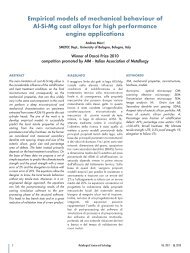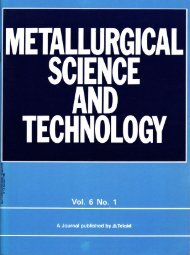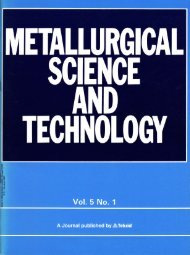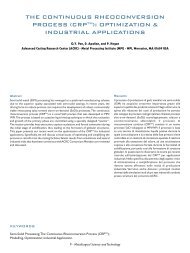PDF, about 5Mb - Teksid Aluminum
PDF, about 5Mb - Teksid Aluminum
PDF, about 5Mb - Teksid Aluminum
Create successful ePaper yourself
Turn your PDF publications into a flip-book with our unique Google optimized e-Paper software.
and can be used to define the relative ductility<br />
parameter, q, see equation 3.<br />
q = s f /n (3)<br />
Defining q = 1 means the onset of necking<br />
represents samples that fail either at the onset of<br />
necking or beyond, while q < 1 identifies lower<br />
quality or less ductile samples. For instance q =<br />
0.5, 0.2, 0.1 identifies samples that fail at 50%, 20%<br />
and 10% of their maximum uniform strain,<br />
respectively.<br />
As observed, the points corresponding to<br />
SDAS = 52 µm are located near the bottom of<br />
the chart, which may be due to their coarser<br />
CONCLUSIONS<br />
As an outcome from the current investigation, the<br />
dendritic cell size, SDAS, and the length of ironbearing<br />
phase whether as needles or Chinese<br />
script, governs the tensile strength and ductility of<br />
Al-Si-Mg alloys. The early fracture of sand and<br />
gravity die cast specimen can be related to the<br />
length of the iron-bearing phase, oxide films<br />
entrapment, and inhomogeneous microstructure<br />
and to the Si particle size and morphology, which<br />
determine the rate of particle cracking with the<br />
applied strain.<br />
• A finer microstructure, small and well<br />
distributed iron-rich compounds and low levels<br />
of porosity exert a beneficial impact on the<br />
resulting mechanical properties.<br />
• The locally increased levels of iron due to<br />
ACKNOWLEDGEMENTS<br />
REFERENCES<br />
1. Metals Handbook; ASM International, 1998, pp.<br />
663-665.<br />
2. M. Avalle, G. Belingardi, M.P. Cavatorta and R.<br />
Doglione, International Journal of Fatigue Vol. 24<br />
, (2002), pp. 1-9.<br />
3. C.H. Cáceres and B.I. Selling , Materials Science<br />
and Engineering A, Vol. 220, Issues 1-2, (1996),<br />
pp. 109-116.<br />
4. M. Harada, T. Suzuki and I. Fukui , Journal of the<br />
Japan foundrymen´s society Vol. 55, No. 12,<br />
(1983), pp. 47-50.<br />
microstructure and the length of the β-phase. As the strength of the gravity<br />
die cast specimens increases, the data points shift toward the upper right<br />
corner.<br />
Regarding the gradient solidified samples, the data points for the<br />
SDAS = 7 µm specimens, with the finer microstructure, exhibit the highest<br />
values of Q and q. These values seem to be the only ones that reach the<br />
limit imposed by the necking line q = 1.<br />
As the SDAS and the level of deleterious microstructural compounds are<br />
decreased, the strength and ductility of the alloy is increased and so does<br />
the Q, allowing for a possible comparison between different alloys and<br />
processing routes. Furthermore, the Si particles, playing a role as reinforcing<br />
phases, decrease in size and the shape becomes more fibrous, which has an<br />
overall beneficial effect on the mechanical properties.<br />
possible segregations might have resulted in longer and larger fractions<br />
of β-phase needles. The main reason for the remarkable reduction of<br />
the mechanical performance of commercial components is proposed<br />
to be due to the presence of the locally induced stresses by the needles<br />
which break, link and propagate the cracks in an unstable manner. The<br />
higher the solidification rate the shorter the length of the needles and<br />
the sounder the material.<br />
• The gradient solidification method shows that the EN AC 43100 alloy<br />
used for commercial cast components processed by sand and gravity<br />
die casting, has an improvement potential to provide sounder castings<br />
with substantial ductility.<br />
• The addition of Mn did not alter the morphology of iron-bearing βphase<br />
into a more compact Chinese script. Instead, these iron<br />
intermetallics seem to be coexisting in the microstructure.<br />
• Porosity is not found to be the primary parameter controlling the tensile<br />
strength and ductility, but it is worth bearing in mind that the reduction<br />
of the load bearing area generally has a harmful influence on the overall<br />
properties.<br />
The authors acknowledge Johan and Jan Tegnemo at Mönsterås Metall AB for their invaluable help and support for making the<br />
experiments in the foundry and Nordic Industrial Fund for the financial support within the Nordic Project STALPK.<br />
5. M.K. Surappa, E. Blank and J.C. Jaquet, Scripta Metallurgica, Vol. 20, No. 9,<br />
(1986), pp. 1281-1286.<br />
6. J.G. Conley, J. Huang, J. Asada and K. Akiba, One Hundred Third Annual<br />
Meeting of the American Foundrymen’s Society; Rosemont, IL; USA, (1998).<br />
pp. 737-742.<br />
7. C.H . Cáceres, Scripta Materialia Vol. 32 No.11, (1995), pp. 1851-1856.<br />
8. C.H. Cáceres, I.L. Svensson, J.A. Taylor, International Journal of Cast Metals<br />
Research, Vol. 15, No. 5, (2003), pp. 531-543.<br />
9. C.H. Cáceres, International Journal of Cast Metals Research, Vol.12, (2000),<br />
pp. 367-375.<br />
10. M. Drouzy, S. Jacob and M.Richard, AFS International Cast Metals Journal,<br />
Vol. 5, No. 2, (1980), pp. 43-50.<br />
22 - Metallurgical Science and Technology







